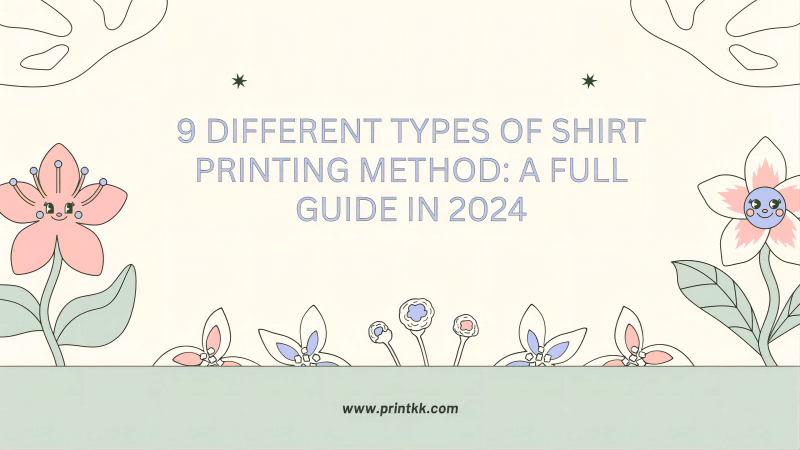
Embark on a creative journey through the diverse world of print on demand. Our guide will illuminate the various types of shirt printing methods, arming you with the knowledge to innovate and impress in 2026.
What Are the Different Types of Shirt Printing?
When exploring shirt printing methods, it's crucial to understand the variety available and how each can uniquely benefit your projects.
First up, we have screen printing, a classic choice known for its vibrant colors and durability. This method involves pushing ink through a fine mesh screen onto the fabric, creating a crisp and long-lasting design. Ideal for bulk orders and designs with fewer colors, screen printing is a go-to for those seeking a traditional yet impactful look.
Next, we have heat transfer printing, a versatile option that allows for intricate designs and gradients. By using heat to transfer the design onto the fabric, this method offers flexibility in design placement and is perfect for small batches or one-off creations.
Whether you're a budding entrepreneur looking to make a statement or an established brand aiming for a polished finish, exploring the different types of shirt printing can help you find the perfect match for your vision.
 (1).jpg)
9 Different Types of Shirt Printing Method
Understanding the various methods available not only helps in choosing the right one for your specific needs but also ensures that your designs shine in the best possible way. Below, we explore nine popular shirt printing methods, each catering to different requirements and artistic visions.
Screen Printing
Screen printing remains one of the most popular and versatile t-shirt printing methods in the industry, particularly appealing to those looking to produce high-volume orders economically.
Its reliability and scalability make it a favorite among entrepreneurs and designers who need a cost-effective solution for large quantities.
Moreover, screen printing excels in durability, making it ideal for designs that are intended for heavy usage or need to withstand the test of time without fading.
For businesses looking to create merchandise that lasts, or artists wanting their designs to stand out with exceptional clarity and vibrancy, screen printing offers a proven route to achieving those goals. This makes it particularly appealing for corporate branding, band merchandise, or any project where longevity and impact are key.
Direct-to-Garment (DTG)
Direct-to-Garment (DTG) printing is a favorite among those looking for precision and versatility in t-shirt printing. This method employs specialized inkjet technology to print detailed, vibrant graphics directly onto the fabric.
Unlike screen printing, which requires setup for each color, DTG allows for unlimited color usage in a single pass, adding to its efficiency for small batch runs.
The appeal of DTG extends to its ease of setup and rapid turnaround times, which can be crucial for businesses operating on tight schedules or those who need to quickly respond to market trends.
This combination of quality, efficiency, and accessibility makes Direct-to-Garment printing a compelling choice for anyone looking to create high-quality, custom apparel with ease.
Dye Sublimation
Dye sublimation is an innovative shirt printing method, and this printing method is particularly effective for polyester and polymer-coated substrates, making it ideal for sports apparel and other garments that require a high degree of flexibility and breathability.
 (1).jpg)
Dye sublimation is also noted for its ability to cover entire garments with edge-to-edge graphics, which cannot be achieved by traditional printing methods. This characteristic makes it extremely popular among brands and designers who want their creative visions to stand out without the constraints of conventional print areas.
Heat Transfer
Heat transfer printing is an accessible entry point for many looking to start their own custom t-shirt business or expand their existing product range. This method involves creating a design on special paper and then using heat and pressure to transfer the ink onto the shirt.
Heat transfer is versatile enough to work on a variety of fabric types and colors, and it excels at producing vibrant, full-color images with a relatively simple setup.
This method allows for detailed and complex designs that would be difficult to achieve with some other printing methods.
Vinyl Cutting
Vinyl cutting is a dynamic shirt printing method highly favored by those requiring durability and the ability to produce bold, clear designs on a variety of fabric types.
Vinyl cutting shines when it comes to producing sports jerseys, slogan tees, and custom apparel that demands a professional, polished look. Its ability to withstand multiple washes without fading or peeling makes it especially suitable for apparel that will be worn and washed frequently.
Whether it's for a corporate event or a personal project, vinyl cutting provides a straightforward and effective solution to meet diverse printing needs.
Plastisol Transfers
Plastisol transfers are a versatile shirt printing method that allows entrepreneurs and designers to prepare designs in advance and apply them to garments as needed.
One of the key benefits of using plastisol transfers is the ability to mass-produce prints and store them until they're ready to be used, making this technique particularly efficient for handling variable demand or seasonal spikes in orders.
Another advantage of plastisol transfers is the high-quality, vibrant prints they produce, which are comparable to direct screen printing results.
Discharge Printing
Discharge printing is a unique method that stands out in the realm of shirt printing, particularly for its ability to create soft, vibrant prints on dark fabrics.
It's particularly effective on 100% cotton shirts, where it removes the shirt's dye without laying extra layers of ink. This results in a print that is much softer to the touch than traditional screen printing, making it highly valued for garments where comfort and a 'no-feel' print are desired.
It's also an excellent choice for businesses seeking a point of difference in a crowded market, offering products that stand out due to their superior hand feel and unique visual appeal.
Water-Based Ink
Water-based ink printing is renowned for its eco-friendly properties and the soft feel it imparts to printed shirts. This type of ink absorbs into the fabric rather than sitting on top of it, which results in exceptionally breathable prints.
As consumers become more environmentally aware, the demand for garments printed with water-based inks continues to grow.
Foil Printing
Foil printing is a spectacular choice for anyone looking to create t-shirts that stand out from the crowd. This method involves the application of a thin metallic film onto the fabric, which gives the final product a shiny, high-end look.
This approach not only differentiates their offerings but also adds a premium touch to their product lineup.
Each printing technique has its unique charm and functionality, making it crucial to consider your project's specific needs, such as fabric type, color requirements, and order volume. By selecting the appropriate method, you ensure the best outcome for your designs, enhancing both the aesthetic appeal and longevity of your shirts.
The Most Popular T-Shirt Printing Types
The t-shirt printing industry has been experiencing significant growth, with two dominant printing methods standing out due to their distinct advantages and popularity: Screen printing and Direct-to-Garment (DTG) printing.
Screen printing is highly valued for its efficiency in large batches, making it the most popular method for bulk orders. This method is especially beneficial for its durability and ability to produce vibrant colors, crucial for high-impact designs.
In terms of printing techniques, screen printing continues to hold a major market share due to its cost-effectiveness and ability to produce vibrant, durable designs, especially on dark-colored apparel. It accounted for over 56% of the market share in 2022. Meanwhile, digital printing is predicted to grow at the fastest compound annual growth rate (CAGR) of around 12% from 2023 to 2030.
On the other hand, DTG printing is renowned for its precision and versatility, allowing for detailed and colorful designs on smaller order quantities. DTG's adaptability in printing detailed graphics on demand makes it ideal for small businesses and individual consumers looking for custom prints.
DTG's market share has grown by approximately 36% over the past five years, reflecting an increasing demand for customized apparel that requires detailed graphics and a softer hand feel.
What Types of T-Shirt Printing Methods Should You Choose?
Choosing the right t-shirt printing method can be pivotal for your brand, especially when you aim to stand out in a crowded market. Each technique offers unique benefits, and your choice will largely depend on your design needs, production volume, and budget.
For those starting out or looking for full-color, complex designs without minimum order requirements, Direct to Garment (DTG) printing is ideal. DTG works much like a desktop printer, applying ink directly onto the shirt, allowing for high levels of detail with minimal setup costs.
However, if you're planning on larger runs of shirts and prioritize durability with a classic feel, screen printing might be your go-to method. Renowned for its vibrant, long-lasting colors, this method involves creating stencils—screens—that are used to apply layers of ink on the printing surface.
Therefore, screen printing is more cost-effective for larger orders where these costs can be spread out over a larger batch. Understanding these nuances will help you choose the most efficient and economical printing method for your project, ensuring quality results that resonate with your audience.
How to Create T-Shirts with PrintKK?
Creating custom t-shirts with PrintKK is an exciting journey that blends creativity with simplicity, making it accessible for anyone from entrepreneurs to artists and even large corporations looking to enhance their brand presence.
At PrintKK, the process starts with choosing the right product from our extensive catalog, which includes premium items like thick cotton t-Shirts and the versatile polyester blends. These options provide a perfect canvas for your designs, whether they're bold graphic prints or subtle company logos.
 (1).png)
 (1).jpg)
Print On Demand Thick Cotton T-Shirts with Automated Fulfillment - PrintKK
Once you've selected your t-shirt, the next step is bringing your design to life using our intuitive design tool. This platform allows you to upload your artwork, manipulate its placement, and experiment with different colors and text additions until you achieve the desired look.
And if you're looking to create a comprehensive brand experience, you can utilize our custom labeling service to add a personal touch to every piece of apparel that ships out.
Whether you're creating a line for a pop-up store or crafting uniforms for your staff, PrintKK makes it simple to manifest your vision into high-quality printed t-shirts that speak volumes about your brand.
Conclusion
As we wrap up our exploration of the different types of shirt printing, it's clear that each method offers unique benefits tailored to specific needs and preferences.
The best shirt printing method is the one that best fits your project's specific requirements, helping turn your creative ideas into wearable art. This knowledge not only optimizes your production process but also ensures that your final product resonates with your intended audience, strengthening your brand's impact in the competitive market.
FAQs
Which method is best for t-shirt printing?
The best method for t-shirt printing depends largely on your specific needs.Each method serves different requirements, balancing quality, quantity, and cost to best fit your project's scope.
What type of t-shirt printing lasts the longest?
Screen printing is renowned for its durability, making it the best choice for t-shirt designs that need to withstand the test of time.
What is the highest quality t-shirt printing?
For those seeking the highest quality t-shirt printing, Direct-to-Garment (DTG) is widely recognized for its superior results.
What is the best image type for t-shirt printing?
For optimal t-shirt printing, vector files are typically the best choice due to their scalability and precision.










 Global Shipping
Global Shipping








 Made in USA
Made in USA





















